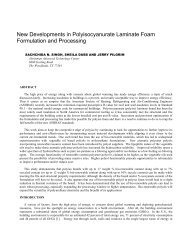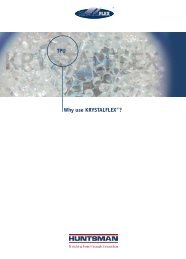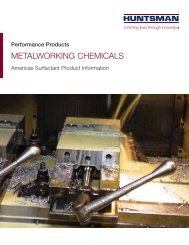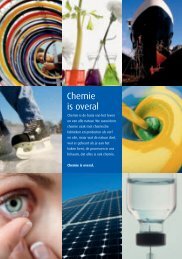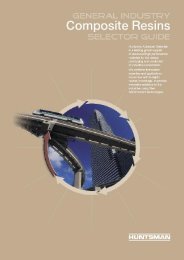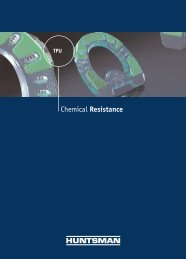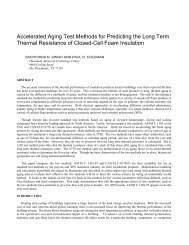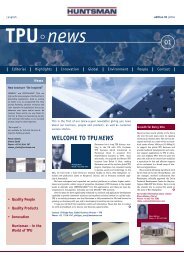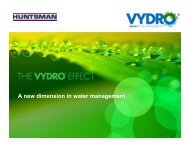NEW DEVELOPMENTS IN POLYETHERAMINE CURING AGENTS
NEW DEVELOPMENTS IN POLYETHERAMINE CURING AGENTS
NEW DEVELOPMENTS IN POLYETHERAMINE CURING AGENTS
Create successful ePaper yourself
Turn your PDF publications into a flip-book with our unique Google optimized e-Paper software.
<strong>NEW</strong> <strong>DEVELOPMENTS</strong> <strong>IN</strong><br />
POLYETHERAM<strong>IN</strong>E CUR<strong>IN</strong>G <strong>AGENTS</strong><br />
David C. Alexander, Bruce L. Burton, Howard P. Klein<br />
Huntsman Petrochemical Corporation<br />
8600 Gosling Rd.<br />
The Woodlands, Texas 77381<br />
281-719-7492<br />
david_alexander@huntsman.com<br />
November 14, 2005<br />
This paper is presented by invitation of TRFA. It is publicly distributed upon request by<br />
the TRFA to assist in the communication of information and viewpoints relevant to the<br />
thermoset industry. The paper and its contents have not been reviewed or evaluated by<br />
the TRFA and should not be construed as having been adopted or endorsed by the<br />
TRFA.
2<br />
<strong>NEW</strong> <strong>DEVELOPMENTS</strong> <strong>IN</strong> POLYETHERAM<strong>IN</strong>E CUR<strong>IN</strong>G <strong>AGENTS</strong><br />
1. <strong>IN</strong>TRODUCTION<br />
David C. Alexander, Bruce L. Burton, Howard P. Klein<br />
Huntsman Corporation – Performance Products<br />
Polyetheramines (PEAs) have been used in many applications since their introduction some<br />
thirty-five years ago. Their value in curing epoxy resins was quickly realized, and this continues<br />
to be a very important market for these materials. 1 At the same time, their uses in other<br />
applications, such as nylon and polyurea modification, continue to grow at a rapid pace. In<br />
recent years we have undertaken to modify their structures in order to expand the scope of their<br />
utility both in epoxy curing and in the newer applications. These modifications include changes<br />
in the amine environment as well as in the backbone structures. In this paper we will describe<br />
some of these structural changes and their effects on the amines’ epoxy curing behavior.<br />
2.0 MODIFICATIONS OF END GROUPS<br />
The reactivity of the primary PEAs is influenced strongly by the steric environment of the<br />
primary amine group. Most members of this family are made by reductive amination of<br />
poly(propylene glycol)-based secondary alcohols and thus have a methyl group adjacent to the<br />
primary amine. The presence of this methyl group moderates the amine reactivity, which results<br />
in relatively slow cure of epoxy resins. In epoxy curing, with a standard liquid resin, the room<br />
temperature pot life is on the order of 4-8 hours for the most commonly used members of this<br />
series (230-400 molecular weight diamines and triamines). While this is advantageous for some<br />
applications, for others a shorter cure time is desirable. Accelerators can, of course, be used for<br />
this purpose, but we sought to expand the product line with amines that are inherently more<br />
reactive to simplify formulation. This can be done by reducing the hindrance around the amine<br />
group.<br />
On the other hand, by increasing the hindrance around the amine group, slower curing agents<br />
can be prepared. Such materials would be of particular use in situations where a longer pot life<br />
is required, such as in fabrication of large composite parts. These new amines differ structurally<br />
from the conventional PEAs in that an ethyl group, rather than a methyl group, is adjacent to the<br />
primary amine. The resulting increased steric hindrance inhibits the approach of the amine to<br />
epoxy resins and slows the reactions.<br />
2.1 FASTER AM<strong>IN</strong>ES<br />
The conventional route to production of PEAs is reductive amination of a secondary alcohol,<br />
which leads to very little formation of secondary amine, an undesirable structure in this<br />
application. Reductive amination of a primary alcohol, however, generally results in the<br />
formation of a significant amount of secondary amine, since the primary amine that is formed<br />
reacts with the primary alcohol starting material. With proper conditions and processing pure<br />
primary amines (such as triethylene glycol diamine, XTJ-504) can be prepared by reductive<br />
amination. We are, however, also using other routes to prepare reactive amines.
3<br />
1, XTJ-504<br />
2, XTJ-590<br />
3, XTJ-548<br />
4, BAPDEG<br />
viscosity, cps<br />
flexural strength, ksi<br />
2.1.1 FASTER AM<strong>IN</strong>ES – BASIC CUR<strong>IN</strong>G DATA<br />
[<br />
H 2N O<br />
H2N<br />
H 2N O<br />
H2N N<br />
O 8<br />
x O 8<br />
750<br />
650<br />
550<br />
450<br />
350<br />
250<br />
150<br />
50<br />
25<br />
20<br />
15<br />
10<br />
5<br />
0<br />
( ) ] (<br />
Viscosity<br />
XTJ-504 XTJ-590 BAPDEG D-230<br />
amine<br />
Flexural Strength<br />
XTJ-504 XTJ-590 BAPDEG D-230<br />
amine<br />
Figure 1. Structures of reactive amines<br />
Figure 2. Epoxy curing properties of faster amines<br />
H<br />
gel time, min<br />
Tg, °C<br />
80<br />
75<br />
70<br />
65<br />
60<br />
55<br />
50<br />
100<br />
95<br />
90<br />
85<br />
80<br />
75<br />
70<br />
65<br />
60<br />
55<br />
50<br />
O<br />
O<br />
Gel Time<br />
O<br />
XTJ-504 XTJ-590 BAPDEG<br />
amine<br />
Glass Transition Temperature<br />
XTJ-504 XTJ-590 BAPDEG D-230<br />
amine<br />
NH2<br />
O NH 2<br />
)<br />
NH 2<br />
O NH 2
The low molecular weight reactive diamines include the previously mentioned TEGDA (1, XTJ-<br />
504) and the similar diamine BAPEG [(bis(aminopropyl)ethylene glycol, 2, XTJ-590)]. A third<br />
amine, PTMEGA-1700 (3, XTJ-548), is a blend of diamine and triamine prepared from a<br />
PTMEG [poly(tetramethylene ether glycol)]. The PTMEGA-1700 blend is much higher in<br />
molecular weight (ca. 1700 average). With its higher equivalent weight, its reactivity will still be<br />
low, but it would be higher than that of a more hindered amine of comparable equivalent weight,<br />
and it may be useful as a flexibilizing blend component.<br />
Some of the basic epoxy curing and cured resin data are shown in Figure 2 for 1 and 2, along<br />
with comparative data for JEFFAM<strong>IN</strong>E ® D-230 amine and bis(aminopropyl) diethylene glycol<br />
(BAPDEG, 4, another commercially available diamine). The gel time for the D-230 amine is not<br />
shown, because this curing agent is too slow to give a discrete gel point with a standard epoxy<br />
resin. For the three reactive amines, the trend is toward lower Tg and lower flexural strength<br />
values with increasing molecular weight. The D-230 amine, however, gives higher Tg and<br />
flexural strength because of the higher rigidity of the poly(propylene glycol) backbone.<br />
Formulated viscosities for the four diamines are similar and are in the 550-750 cps range; they<br />
decrease with increasing molecular weight for the three reactive amines.<br />
As would be expected, these amines are useful in many epoxy adhesive formulations. Lap<br />
shear strengths, with a heat cure, are in the 3000-3500 psi range (acid-etched aluminum).<br />
The structure 3 is obviously very different, with a much higher amine hydrogen equivalent<br />
weight (AHEW); furthermore, it consists mainly of two components, with x = 0 and 1. Since the<br />
backbone structure would probably be considered the most significant feature of this amine<br />
blend, it will be described in the “New Backbones” section.<br />
4<br />
2.1.2 FASTER AM<strong>IN</strong>ES – COAT<strong>IN</strong>GS DATA<br />
The highest volume commercial use for epoxy resins remains today in the paints and coatings<br />
sector. The PEA products have found a wide variety of applications in coatings, but have some<br />
restrictions due to reduced chemical resistance for industrial and maintenance coatings.<br />
However, in some of these areas, smaller amounts of PEA materials may be used in these<br />
formulations to provide benefits in processing and properties. The PEA products have found<br />
wide applications in high-build, 100 % solids coatings for decorative or decoupage coatings,<br />
floor coatings and some architectural coatings.<br />
The clear coating formulations in Table 5 are examples of high-build clear coatings, which find<br />
uses in decoupage epoxy systems for decorative coatings, labels, costume jewelry and other<br />
items, such as synthetic water in floral displays. Use of the PEA as sole curing agents in these<br />
systems will result in a highly clear, colorless epoxy coating, but these may cure too slowly<br />
when using JEFFAM<strong>IN</strong>E ® D-230 or T-403 amines. Also, these coatings may show a tendency<br />
to blush slightly under low temperature and high humidity conditions.<br />
Addition of an alkylphenol, such as p-nonylphenol (MNP), will sufficiently speed the curing<br />
reaction and reduce any tendency for blushing with these products. However, the coating may<br />
be too soft at typically used levels of MNP (around 30%). The addition of smaller amounts of an<br />
aliphatic amine, such as AEP, will help to both harden the coating and further speed their drying<br />
times without any signs of blushing or surface imperfections.
If the more reactive PEA products, such as XTJ-504 and XTJ-590, are used by themselves to<br />
cure clear coatings, these would blush under most ambient conditions. Therefore the use of<br />
MNP is necessary for blush prevention, though it significantly reduces working time of the<br />
formulations. In all cases for the coatings in Table 5, the epoxy resin is mixed well with the<br />
hardener formulation, prior to the draw down of the coating. Some people may choose to add<br />
more or less MNP to create formulations having convenient mix ratios. Although a slight excess<br />
of epoxy resin or amine, away from a 1:1 stoichiometry may give properties sufficient for some<br />
applications, the best properties, having the most consistent, long-term performance will be<br />
obtained near a 1:1 ratio of amine-hydrogen to epoxide groups. In some commercial<br />
applications these systems are poured onto the wood, ceramic or metal substrates and allowed<br />
to self-level during curing. Pigments, fillers and other additives may be included to achieve the<br />
desired appearance.<br />
During this work we saw that (data not shown) increasing the MNP level from 31 to 35 weight<br />
percent in a XTJ-590 formulation (similar to that in table 1) produced much softer coatings,<br />
reducing their pendulum hardness by 66%. Also, in those coatings formulated with the XTJ-504<br />
and XTJ-590 the greatly increased curing speed of these already fast systems caused systems<br />
warmed to 50°C to gel in fifteen minutes or less in a forty gram mass. Blending with the less<br />
reactive amines can be used to slow these reactions, as desired.<br />
The amount of MNP may be adjusted to control reactivity, flexibility, and adjust mix ratios for the<br />
formulator. Mix ratios of resin to hardener will often vary somewhere within the range of 2/1 to<br />
1/1 by volume, depending on the resulting application. For decorative coatings the 1/1 ratio is<br />
most popular, while 2/1 is more popular in self-leveling, seamless flooring systems. Because<br />
the densities of the components involved differ from one another, volume ratios and weight<br />
ratios may not be interchanged without affecting processing and performance.<br />
In seamless flooring systems, working times may be adjusted for use in summer and in winter<br />
applications, where faster curing is needed at lower temperatures. When using the more<br />
reactive PEA products in wintertime epoxy flooring systems, we recommend that derivatives,<br />
such as epoxy adducts or Mannich bases of the XTJ-504 or XTJ-590, be prepared and added to<br />
the epoxy system, along with a suitable diluent to compensate for their higher viscosity. Such<br />
diluents may be products like JEFFAM<strong>IN</strong>E ® D-230 amine (reactive diluent) or benzyl alcohol<br />
(non-reactive diluent). Using such epoxy adducts or Mannich base hardeners, blushing<br />
tendencies can be significantly reduced when curing is done at cold temperatures.<br />
Amines having a wide range of reactivity are available to the formulator and may be combined<br />
to provide an optimum balance of processing speed and final cured properties. Amines like<br />
XTJ-504 and XTJ-590 are particularly fast compared to well-known PEAs like JEFFAM<strong>IN</strong>E ® D-<br />
230 and T-403 amines. The use of MNP (mono-nonyl phenol) in conjunction with the fastest<br />
amines can suppress the blushing that occurs when they are used as the sole curing agent.<br />
Increasing MNP levels can greatly decrease the hardness of these formulations however some<br />
hardness may be regained by using some AEP or other cycloaliphatic amines in the formulation.<br />
The coatings formulations containing TEGDA and BAPEG amines gave significantly faster<br />
drying times, excellent gloss, and excellent conical mandrel bend values. Though they also<br />
showed lower impact and crosshatch adhesion strengths than the JEFFAM<strong>IN</strong>E ® products, they<br />
may still be used to adjust reactivity and other properties in some applications. Maintaining an<br />
amine-epoxy mix ratio near a 1:1 stoichiometry is desirable for the optimization of some<br />
properties such as Tg, hardness, and surface appearance.<br />
5
6<br />
Curing agent components concentrations, phr, in standard liquid resin<br />
Liquid Epoxy Resin 100 100 100<br />
XTJ-504 15.7<br />
XTJ-590 19.3<br />
JEFFAM<strong>IN</strong>E ® -230 26.2<br />
Decoupage Monononylphenol<br />
(MNP), 31.0 Wt. % 53.8 55.4 58.5<br />
Aminoethylpiperazine (AEP) 4 4 4<br />
Coatings properties, 3 mil<br />
Film Thickness, mil.<br />
Dry Time, hours<br />
3 3.3 3.3<br />
a) Set to touch 2.3 1.8 3.8<br />
b) Surface Dry 3.3 2.3 5.3<br />
c) Through Dry<br />
Pendulum Hardness, Koenig, 20ºC<br />
4.1 3.4 6.8<br />
1 day 39 34 22<br />
7 days 68 51 63<br />
Crosscut Adhesion, 7 days, ASTM D 3359-95<br />
Method B: Rating / % Removed with tape<br />
0 / 90 0 / 100 5/0<br />
Gloss, 20º, 1 day / 7 days 108 / 109 106 / 108 109 / 111<br />
Gloss, 60º, 1 day / 7 days 123 / 123 116 / 121 123 / 124<br />
Gardner Impact, direct, 7 days > 160 110 > 160<br />
Gardner Impact, reverse, 7 days 140 120 > 160<br />
Conical Mandrel Bend Pass Pass Pass<br />
Appearance<br />
2.2 SLOWER AM<strong>IN</strong>ES<br />
High gloss, no<br />
blushing<br />
Table 1. Coatings properties with faster amines<br />
High gloss, no<br />
blushing<br />
High gloss, no<br />
blushing<br />
In this paper we are focusing on two examples of the slower curing agents, a butylene oxideterminated<br />
diamine (XTJ-568) and a butylene oxide-terminated triamine (XTJ-566) 2 . The amine<br />
end groups of these two products are identical and are shown in Figure 3; the conventional PEA<br />
termination is also shown for comparison.
Figure 4 provides an illustration of the effect of replacing methyl groups with ethyl groups. It is<br />
clear that the pot life for formulations with these amines will be significantly longer. The AHEW<br />
for the XTJ-568 amine is similar to that of the JEFFAM<strong>IN</strong>E ® D-230 amine (55 vs. 60), but a little<br />
lower, so any concentration effect would tend to favor a faster reaction. Likewise, the AHEW for<br />
the XTJ-566 amine is similar to, but slightly lower than, that of the T-403 amine. The rate of<br />
viscosity increase for T-403 amine-based formulations is not shown here, but it is similar to that<br />
of D-230 amine/epoxy formulations.<br />
As far as other epoxy curing and cured resin properties are concerned, the behavior of the new<br />
slower curing agents is quite similar to that of existing PEA products. Comparative plots for<br />
several properties are shown in Figure 5. It can be seen that mix ratios, viscosities, and cured<br />
resin flexural strengths are similar; the glass transition temperatures of the slow amines are<br />
slightly higher. Variations in starting polyol structure, somewhat lower AHEW, and higher<br />
rigidity in the terminal groups are responsible for the higher values. Elongation values, like<br />
7<br />
Conventional<br />
polyetheramine<br />
termination<br />
Viscosity - centipoise<br />
10000<br />
9000<br />
8000<br />
7000<br />
6000<br />
5000<br />
4000<br />
3000<br />
2000<br />
1000<br />
0<br />
Figure 3. Comparison of amine environments<br />
Viscosity vs. Time - Cure at 40°C<br />
JEFFAM<strong>IN</strong>E D-230<br />
0.00 0.50 1.00 1.50 2.00 2.50 3.00 3.50 4.00 4.50 5.00<br />
Time - hours<br />
Figure 4. Comparison of epoxy curing rates<br />
XTJ-566<br />
More hindered<br />
polyetheramine<br />
termination<br />
XTJ-568
those given by conventional PEAs, are in the 8-12% range. These data suggest that, for those<br />
applications which would benefit from longer pot life, these new, more hindered curing agents<br />
provide a good alternative to existing PEAs. They may be of particular value in slowing the<br />
cure of formulations based on faster amines; variations in the fast amine/slow amine ratio would<br />
allow the formulator to tailor a basic formulation according to conditions such as working<br />
temperature or required working time.<br />
8<br />
mix ratio, phr<br />
T g , °C<br />
45<br />
40<br />
35<br />
30<br />
25<br />
20<br />
15<br />
10<br />
5<br />
0<br />
110<br />
100<br />
90<br />
80<br />
70<br />
60<br />
50<br />
Mix Ratio<br />
XTJ-568 D-230 XTJ-566 T-403<br />
amine<br />
Glass Transition Temperature<br />
XTJ-568 D-230 XTJ-566 T-403<br />
amine<br />
3.0 MODIFICATIONS <strong>IN</strong> BACKBONE STRUCTURES<br />
viscosity, cps<br />
1800<br />
1600<br />
1400<br />
1200<br />
1000<br />
800<br />
600<br />
400<br />
200<br />
0<br />
Viscosity<br />
XTJ-568 D-230 XTJ-566 T-403<br />
amine<br />
Flexural Strength<br />
The other significant expansion to the PEA family includes amines with different backbone<br />
segments. Although the amines based on poly(propylene glycol) and poly(ethylene glycol) are<br />
suitable for a variety of applications, others would benefit from a backbone that is more<br />
hydrophobic or that gives better mechanical properties. To address these needs we now have<br />
several developmental products that contain varying levels of backbone substitution by<br />
poly(tetramethylene ether glycol) (PTMEG) segments.<br />
As discussed previously, most of the PEA products are made by amination of secondary<br />
alcohols. Since the PTMEGs contain primary alcohol termination, in most cases they are<br />
propoxylated to provide secondary alcohol end groups. Amination of these diols gives the<br />
flexural strength, ksi<br />
19<br />
17<br />
15<br />
13<br />
11<br />
9<br />
7<br />
5<br />
XTJ-568 D-230 XTJ-566 T-403<br />
amine
difunctional primary amines with minimal secondary amine content. Products with mixed<br />
PTMEG/PPG backbones are available in molecular weights ranging from 1000 to 2000. Most of<br />
the exploratory work in epoxy curing has been done with the 1000 mw product, XTJ-542.<br />
One product, however, is made by direct amination of a PTMEG. This material, the XTJ-548<br />
mentioned earlier, is a blend of a di(primary) amine (with relatively reactive amines) and a<br />
triamine with two primary amines and one secondary amine.<br />
Because these PTMEG/PPG- and PTMEG-based products range in molecular weight from<br />
1000 to 2000, their main use would be as flexibilizing curing agents. Used in combination with<br />
lower molecular weight curing agents, such as the conventional PEAs, they can be part of<br />
formulations that give higher elongations than typical epoxy formulations for applications where<br />
increased flexibility is an advantage.<br />
It should be noted also that few PEAs with molecular weights around 1000 have previously<br />
been available. (One exception is a very hydrophilic, PEG-based product of 900 molecular<br />
weight.) Thus the XTJ-542, aside from being novel in its backbone structure, fills a gap that has<br />
existed for less hydrophilic amines – no conventional, PPG-based diamine product of this<br />
molecular weight has been available.<br />
Table 1 shows examples of formulations that combine XTJ-542 with the JEFFAM<strong>IN</strong>E ® D-230 or<br />
D-400 amines; the data can be compared with literature formulations that combine the D-400<br />
amine with the D-2000 amine. The XTJ-542, with a molecular weight half that of the D-2000<br />
amine, gives much higher tensile strength values along with slightly higher elongations. The<br />
glass transition temperatures for these formulations are around room temperature to slightly<br />
above, and the formulated viscosities are typical of PEA formulations. Several of the<br />
formulations give elongations greater than 100%, while those with T-403 are in the intermediate<br />
range.<br />
The other type of new amine with the PTMEG backbone is made by amination without<br />
propoxylation, which leads to formation of a significant amount of secondary amine. This<br />
product, XTJ-548, can be used in much the same way as XTJ-542, in combination with lower<br />
molecular weight amines. Some of these formulations and their properties are shown in Table<br />
2. Of particular note are the formulations that combine XTJ-548 and monoethanolamine (MEA)<br />
or DGA ® Agent (N-aminoethyl ethanolamine); these curing agent blends combine relatively fast<br />
cure (35-45 minute gel times) with high elongation values of 150-300% in the cured resins 3 .<br />
These fast gel times are obtained without accelerators; the low molecular weight aminoalcohols<br />
are themselves potent accelerators because of their low molecular weight and high amine and<br />
alcohol content. Because they are monoamines they do not increase the crosslink density as is<br />
typical of diamines, so the cured resins have a high degree of flexibility along with the rapid<br />
cures. One minor drawback of using the aminoalcohols, however, is increased sensitivity to<br />
polar solvents such as acetone.<br />
9
10<br />
Curing agent components concentrations, phr, in standard liquid resin<br />
XTJ-548 26 26 35 35 35 35<br />
JEFFAM<strong>IN</strong>E ® D-2000 25 25<br />
JEFFAM<strong>IN</strong>E D-400 52 52 50 50<br />
DGA ® Agent 24 24<br />
MEA 14 14<br />
Accelerator 399 5 10<br />
Properties<br />
Viscosity, cps 800 600 950 1800<br />
Gel time, min 46 35<br />
Tg, °C 33 22 40<br />
Cure conditions heat rt heat rt heat rt heat rt<br />
Flexural strength, psi 6600<br />
Flexural modulus, psi 180000<br />
Tensile strength, psi 2150 2000 1700 1700 2150 5150 4300<br />
Elongation at break, % 100 150 86 73 300 150 136<br />
% Wt gain, 24 hr water boil 2.2 3.9 2.6 1.2 6.4 6.4 5.5 5.7<br />
% Wt gain, 3 hr acetone boil 29 28 30 33 42 42 27 31<br />
Curing agent components concentrations, phr, in standard liquid resin<br />
XTJ-542 22 22 40 40 33 33<br />
JEFFAM<strong>IN</strong>E ® D-2000 25 25<br />
JEFFAM<strong>IN</strong>E D-400 44 44 50 50 40 40<br />
JEFFAM<strong>IN</strong>E T-403 33 33<br />
Accelerator 399 10 10 10 5<br />
Properties<br />
Table 2. Epoxy curing with XTJ-548<br />
Viscosity, cps 700 600 450 1800<br />
Tg, °C 35 33 25 43<br />
Cure conditions heat rt heat rt heat rt heat rt<br />
Flexural strength, psi 5500 -- -- -- -- -- 11500 7600<br />
Flexural modulus, psi 195000 -- -- -- -- -- 337000 230000<br />
Tensile strength, psi 3500 2400 1700 1700 1250 570 6500 4100<br />
Elongation at break, % 115 125 86 73 145 95 12 48<br />
% Wt gain, 24 hr water boil 2.7 2.8 2.6 1.2 2.4 2.6 2.5 4.3<br />
% Wt gain, 3 hr acetone boil 23 25 30 33 33 27 15 20<br />
Table 3. Epoxy curing with XTJ-542
4.0 CONCLUSIONS<br />
Through the structural changes to the PEAs described in this paper Huntsman has expanded<br />
the range of reactivities provided by this family of curing agents. Although the more reactive<br />
amines have been commercially available for some time, the slower ones are novel. A<br />
considerable amount of control over cure rate can be achieved through control of the<br />
environment around the amine, and we are exploring more new materials with such<br />
modifications. Examples of applications for slower amines are fabrication of large composite<br />
parts, where more working time is required, or wood consolidation, where longer times are<br />
required for the curing epoxy to penetrate into a wooden structure.<br />
Likewise, changes in the PEA backbone structure can be used to tailor the properties of cured<br />
resins. The PTMEG diols are considered to be premium products for polyurethanes, and some<br />
advantages in mechanical properties might be expected in cured epoxy resins as well.<br />
REFERENCES<br />
1. “Epoxy Formulations Using JEFFAM<strong>IN</strong>E ® Polyetheramines” Huntsman Technical Publication, 2005<br />
2. Klein, H. P. et al. World Patent App. WO2004/020506<br />
3. This combination of high molecular weight polyetheramines and low molecular weight aminoalcohols was first reported by Lin, J.-<br />
J., Tseng, F.-P., Chang, F.-C. Polymer International 2000, 49, 387-394<br />
All information contained herein is provided "as is" without any warranties, express or implied, and under no circumstances shall the<br />
authors or Huntsman be liable for any damages of any nature whatsoever resulting from the use or reliance upon such information.<br />
Nothing contain in this publication should be construed as a license under any intellectual property right of any entity, or as a<br />
suggestion, recommendation, or authorization to take any action that would infringe any patent. The term "Huntsman" is used herein<br />
for convenience only, and refers to Huntsman Petrochemical Corporation, its direct and indirect affiliates, and their employees,<br />
officers, and directors.<br />
11



